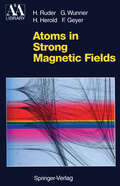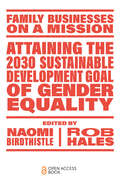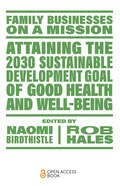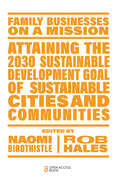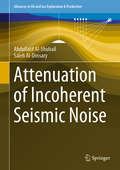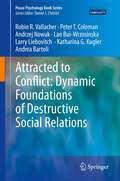- Table View
- List View
Atoms and Molecules in Strong External Fields
by P. Schmelcher W. SchweizerThis book contains contributions to the 172. WE-Heraeus-Seminar “Atoms and Molecules in Strong External Fields,” which took place April 7–11 1997 at the Phys- zentrum Bad Honnef (Germany). The designation “strong fields” applies to external static magnetic, and/or electric fields that are sufficiently intense to cause alterations in the atomic or molecular str- ture and dynamics. The specific topics treated are the behavior and properties of atoms in strong static fields, the fundamental aspects and electronic structure of molecules in strong magnetic fields, the dynamics and aspects of chaos in highly excited R- berg atoms in external fields, matter in the atmosphere of astrophysical objects (white dwarfs, neutron stars), and quantum nanostructures in strong magnetic fields. It is obvious that the elaboration of the corresponding properties in these regimes causes the greatest difficulties, and is incomplete even today. Present-day technology has made it possible for many research groups to study the behavior of matter in strong external fields, both experimentally and theore- cally, where the phrase “experimentally” includes the astronomical observations. - derstanding these systems requires the development of modern theories and powerful computational techniques. Interdisciplinary collaborations will be helpful and useful in developing more efficient methods to understand these important systems. Hence the idea was to bring together people from different fields like atomic and molecular physics, theoretical chemistry, astrophysics and all those colleagues interested in aspects of few-body systems in external fields.
Atoms in Strong Fields (Nato Science Series B: #212)
by Efthymios Nicolaidis Charles W. Clark Munir H. NayfehThis book collects the lectures given at the NATO Advanced Study Institute on "Atoms in Strong Fields", which took place on the island of Kos, Greece, during the two weeks of October 9-21,1988. The designation "strong field" applies here to an external electromagnetic field that is sufficiently strong to cause highly nonlinear alterations in atomic or molecular struc ture and dynamics. The specific topics treated in this volume fall into two general cater gories, which are those for which strong field effects can be studied in detail in terrestrial laboratories: the dynamics of excited states in static or quasi-static electric and magnetic fields; and the interaction of atoms and molecules with intense laser radiation. In both areas there exist promising opportunities for research of a fundamental nature. An electric field of even a few volts per centimeter can be very strong on the atom ic scale, if it acts upon a weakly bound state. The study of Rydberg states with high reso lution laser spectroscopic techniques has made it possible to follow the transition from weak-field to strong-field behavior in remarkable detail, using static fields of modest lab oratory strength; in the course of this transition the atomic system evolves from one which can be thoroughly understood in terms of field-free quantum numbers, to one which cannot be meaningfully associated at all with the zero-field states of the atom.
Atoms in Strong Magnetic Fields: Quantum Mechanical Treatment and Applications in Astrophysics and Quantum Chaos (Astronomy and Astrophysics Library)
by Hanns Ruder Günter Wunner Heinz Herold Florian GeyerA clear and accessible introduction to quantum mechanical methods used to calculate properties of atoms exposed to strong magnetic fields in both laboratory and stellar environments, with the emphasis on hydrogen and helium and their isoelectronic sequences. The results of the detailed calculations are listed in tables, making it a useful handbook for astrophysicists and atomic physicists alike.
Atoms, Solids, and Plasmas in Super-Intense Laser Fields
by Dimitri Batani Charles J. Joachain S. Martellucci Arthur N. ChesterThe recent developement of high power lasers, delivering femtosecond pulses of 20 2 intensities up to 10 W/cm , has led to the discovery of new phenomena in laser interactions with matter. At these enormous laser intensities, atoms, and molecules are exposed to extreme conditions and new phenomena occur, such as the very rapid multi photon ionization of atomic systems, the emission by these systems of very high order harmonics of the exciting laser light, the Coulomb explosion of molecules, and the acceleration of electrons close to the velocity of light. These phenomena generate new behaviour of bulk matter in intense laser fields, with great potential for wide ranging applications which include the study of ultra-fast processes, the development of high-frequency lasers, and the investigation of the properties of plasmas and condensed matter under extreme conditions of temperature and pressure. In particular, the concept of the "fast ignitor" approach to inertial confinement fusion (ICF) has been proposed, which is based on the separation of the compression and the ignition phases in laser-driven ICF. The aim of this course on "Atom, Solids and Plasmas in Super-Intense Laser fields" was to bring together senior researchers and students in atomic and molecular physics, laser physics, condensed matter and plasma physics, in order to review recent developments in high-intensity laser-matter interactions. The course was held at the Ettore Majorana International Centre for Scientific Culture in Erice from July 8 to July 14,2000.
The Attacking Ocean: The Past, Present, and Future of Rising Sea Levels
by Brian FaganThe past fifteen thousand years - the entire span of human civilization - have witnessed dramatic sea level changes, which began with rapid global warming at the end of the Ice Age, when sea levels were more than 700 feet below modern levels. Over the next eleven millennia, the oceans climbed in fits and starts. These rapid changes had little effect on those humans who experienced them, partly because there were so few people on earth, and also because they were able to adjust readily to new coastlines.Global sea levels stabilised about six thousand years ago except for local adjustments that caused often quite significant changes to places like the Nile Delta. So the curve of inexorably rising seas flattened out as urban civilizations developed in Egypt, Mesopotamia, and South Asia. The earth's population boomed, quintupling from the time of Christ to the Industrial Revolution. The threat from the oceans increased with our crowding along shores to live, fish, and trade.Since 1860, the world has warmed significantly and the ocean's climb has speeded. The sea level changes are cumulative and gradual; no one knows when they will end. The Attacking Ocean tells a tale of the rising complexity of the relationship between humans and the sea at their doorsteps, a complexity created not by the oceans, which have changed but little. What has changed is us, and the number of us on earth.
The Attacking Ocean: The Past, Present, and Future of Rising Sea Levels
by Brian FaganThe past fifteen thousand years-the entire span of human civilization-have witnessed dramatic sea level changes, which began with rapid global warming at the end of the Ice Age, when coastlines were more than seven hundred feet below modern levels. Over the next ten millennia, the oceans climbed in fits and starts. These rapid changes had little effect on those humans who experienced them, partly because there were so few people on earth, and also because those people were able to adjust readily to new coastlines.Global sea levels stabilized about six thousand years ago, except for local adjustments that caused often significant changes to places such as the Nile Delta. The curve of inexorably rising seas flattened out as urban civilizations developed in Egypt, Mesopotamia, and South Asia. The earth's population boomed, quintupling from the time of Christ to the Industrial Revolution. The threat from the oceans increased with our crowding along shores to live, fish, and trade.Since 1860, the world has warmed significantly and the ocean's climb has accelerated. The sea level changes are cumulative and gradual; no one knows when they will end. The Attacking Ocean, from celebrated author Brian Fagan, tells a tale of the rising complexity of the relationship between humans and the sea at their doorsteps, a complexity created not by the oceans, which have changed little. What has changed is us, and the number of us on earth.
Attaining the 2030 Sustainable Development Goal of Climate Action (Family Businesses on a Mission)
by Naomi Birdthistle Rob HalesAttaining the 2030 Sustainable Development Goal of Climate Action focuses on Sustainable Development Goal number thirteen (SDG13): urgent action to combat climate change and its impacts. Examining family businesses in Germany, Australia, the United States and the United Kingdom, each case study presents a unique perspective from their respective countries of how SDG13 translates into strategy, culture, and the practice of doing business, providing insights and key takeaways into how family businesses can play a role in combatting climate change. The United Nations’ (UN) Sustainable Development Goals (SDGs) are 17 Goals pledged by 193 nations in 2015 which would help engender an improved, fairer, and more sustainable world – one in which ‘no one is left behind’. The SDGs are a call to action, to develop innovative solutions to the most complex, societal, and environmental global challenges. In Family Businesses on a Mission, series editors Naomi Birdthistle and Rob Hales bring together international case studies to illustrate how family businesses can attain the UN 2030 SDGs. Accessible to those working in the field beyond academia – such as family business practitioners, family business owners, government and policymakers, members of NGOs, business associations and philanthropic centres – the book series equally appeals to those with a general interest in entrepreneurship and business.
Attaining the 2030 Sustainable Development Goal of Climate Action (Family Businesses on a Mission)
by Naomi Birdthistle, Rob HalesAttaining the 2030 Sustainable Development Goal of Climate Action focuses on Sustainable Development Goal number thirteen (SDG13): urgent action to combat climate change and its impacts. Examining family businesses in Germany, Australia, the United States and the United Kingdom, each case study presents a unique perspective from their respective countries of how SDG13 translates into strategy, culture, and the practice of doing business, providing insights and key takeaways into how family businesses can play a role in combatting climate change. The United Nations’ (UN) Sustainable Development Goals (SDGs) are 17 Goals pledged by 193 nations in 2015 which would help engender an improved, fairer, and more sustainable world – one in which ‘no one is left behind’. The SDGs are a call to action, to develop innovative solutions to the most complex, societal, and environmental global challenges. In Family Businesses on a Mission, series editors Naomi Birdthistle and Rob Hales bring together international case studies to illustrate how family businesses can attain the UN 2030 SDGs. Accessible to those working in the field beyond academia – such as family business practitioners, family business owners, government and policymakers, members of NGOs, business associations and philanthropic centres – the book series equally appeals to those with a general interest in entrepreneurship and business.
Attaining the 2030 Sustainable Development Goal of Decent Work and Economic Growth (Family Businesses on a Mission)
by Naomi Birdthistle Rob HalesAttaining the 2030 Sustainable Development Goal of Decent Work and Economic Growth focuses on Sustainable Development Goal number eight (SDG8): inclusive and sustainable economic growth and productive employment for all. Examining family businesses in Brazil, UK, Australia, and Algeria, each case study presents a unique perspective from their respective countries of how the SDG8 translates into culture and the practice of doing business, providing insights and key takeaways into how family businesses can play a role promoting decent work and economic growth. The United Nations’ (UN) Sustainable Development Goals (SDGs) are 17 Goals pledged by 193 nations in 2015 which would help engender an improved, fairer, and more sustainable world – one in which ‘no one is left behind’. The SDGs are a call to action, to develop innovative solutions to the most complex, societal, and environmental global challenges. In Family Businesses on a Mission, series editors Naomi Birdthistle and Rob Hales bring together international case studies to illustrate how family businesses can attain the UN 2030 SDGs. Accessible to those working in the field beyond academia – such as family business practitioners, family business owners, government and policymakers, members of NGOs, business associations and philanthropic centres – the book series equally appeals to those with a general interest in entrepreneurship and business.
Attaining the 2030 Sustainable Development Goal of Decent Work and Economic Growth (Family Businesses on a Mission)
by Naomi Birdthistle, Rob HalesAttaining the 2030 Sustainable Development Goal of Decent Work and Economic Growth focuses on Sustainable Development Goal number eight (SDG8): inclusive and sustainable economic growth and productive employment for all. Examining family businesses in Brazil, UK, Australia, and Algeria, each case study presents a unique perspective from their respective countries of how the SDG8 translates into culture and the practice of doing business, providing insights and key takeaways into how family businesses can play a role promoting decent work and economic growth. The United Nations’ (UN) Sustainable Development Goals (SDGs) are 17 Goals pledged by 193 nations in 2015 which would help engender an improved, fairer, and more sustainable world – one in which ‘no one is left behind’. The SDGs are a call to action, to develop innovative solutions to the most complex, societal, and environmental global challenges. In Family Businesses on a Mission, series editors Naomi Birdthistle and Rob Hales bring together international case studies to illustrate how family businesses can attain the UN 2030 SDGs. Accessible to those working in the field beyond academia – such as family business practitioners, family business owners, government and policymakers, members of NGOs, business associations and philanthropic centres – the book series equally appeals to those with a general interest in entrepreneurship and business.
Attaining the 2030 Sustainable Development Goal of Gender Equality (Family Businesses on a Mission)
by Naomi Birdthistle Rob HalesThe ebook edition of this title is Open Access and freely available to read online. Attaining the 2030 Sustainable Development Goal of Gender Equality focuses on Sustainable Development Goal number five (SDG#5): ending all forms of discrimination against women and girls. Examining family businesses in Honduras, Australia, Austria, and Lebanon, each case study presents a unique perspective from their respective country, analysing how SDG#5 translates into empowering women and girls around the world. The case studies presented generate insights and key takeaways into the role of family businesses in eliminating violence and other harmful practices as well as ensuring equal opportunities and participation for women in business and beyond. The United Nations’ (UN) Sustainable Development Goals (SDGs) are 17 Goals pledged by 193 nations in 2015 which would help engender an improved, fairer, and more sustainable world – one in which ‘no one is left behind’. The SDGs are a call to action, to develop innovative solutions to the most complex, societal, and environmental global challenges. In Family Businesses on a Mission, series editors Naomi Birdthistle and Rob Hales bring together international case studies to illustrate how family businesses can attain the UN 2030 SDGs. Accessible to those working in the field beyond academia – such as family business practitioners, family business owners, government and policymakers, members of NGOs, business associations and philanthropic centres – this book series equally appeals to those with a general interest in entrepreneurship and business.
Attaining the 2030 Sustainable Development Goal of Gender Equality (Family Businesses on a Mission)
by NAOMI BIRDTHISTLE AND ROB HALESThe ebook edition of this title is Open Access and freely available to read online. Attaining the 2030 Sustainable Development Goal of Gender Equality focuses on Sustainable Development Goal number five (SDG#5): ending all forms of discrimination against women and girls. Examining family businesses in Honduras, Australia, Austria, and Lebanon, each case study presents a unique perspective from their respective country, analysing how SDG#5 translates into empowering women and girls around the world. The case studies presented generate insights and key takeaways into the role of family businesses in eliminating violence and other harmful practices as well as ensuring equal opportunities and participation for women in business and beyond. The United Nations’ (UN) Sustainable Development Goals (SDGs) are 17 Goals pledged by 193 nations in 2015 which would help engender an improved, fairer, and more sustainable world – one in which ‘no one is left behind’. The SDGs are a call to action, to develop innovative solutions to the most complex, societal, and environmental global challenges. In Family Businesses on a Mission, series editors Naomi Birdthistle and Rob Hales bring together international case studies to illustrate how family businesses can attain the UN 2030 SDGs. Accessible to those working in the field beyond academia – such as family business practitioners, family business owners, government and policymakers, members of NGOs, business associations and philanthropic centres – this book series equally appeals to those with a general interest in entrepreneurship and business.
Attaining the 2030 Sustainable Development Goal of Good Health and Well-Being (Family Businesses on a Mission)
by Naomi Birdthistle Rob HalesThe ebook edition of this title is Open Access and freely available to read online. Attaining the 2030 Sustainable Development Goal of Good Health and Well-Being focuses on Sustainable Development Goal number three (SDG#3): prioritising the emotional and physical health of humans around the world. Examining family businesses in Germany, Malaysia, Mexico, and Australia, each case study presents a unique perspective from their respective country, analysing how SDG#3 translates into ensuring healthy lives and promoting well-being for all. The case studies presented generate insights and key takeaways into the role of family businesses in fostering safety and equality in healthcare systems and infrastructure across the globe. The United Nations’ (UN) Sustainable Development Goals (SDGs) are 17 Goals pledged by 193 nations in 2015 which would help engender an improved, fairer, and more sustainable world – one in which ‘no one is left behind’. The SDGs are a call to action, to develop innovative solutions to the most complex, societal, and environmental global challenges. In Family Businesses on a Mission, series editors Naomi Birdthistle and Rob Hales bring together international case studies to illustrate how family businesses can attain the UN 2030 SDGs. Accessible to those working in the field beyond academia – such as family business practitioners, family business owners, government and policymakers, members of NGOs, business associations and philanthropic centres – this book series equally appeals to those with a general interest in entrepreneurship and business.
Attaining the 2030 Sustainable Development Goal of Good Health and Well-Being (Family Businesses on a Mission)
by NAOMI BIRDTHISTLE AND ROB HALESThe ebook edition of this title is Open Access and freely available to read online. Attaining the 2030 Sustainable Development Goal of Good Health and Well-Being focuses on Sustainable Development Goal number three (SDG#3): prioritising the emotional and physical health of humans around the world. Examining family businesses in Germany, Malaysia, Mexico, and Australia, each case study presents a unique perspective from their respective country, analysing how SDG#3 translates into ensuring healthy lives and promoting well-being for all. The case studies presented generate insights and key takeaways into the role of family businesses in fostering safety and equality in healthcare systems and infrastructure across the globe. The United Nations’ (UN) Sustainable Development Goals (SDGs) are 17 Goals pledged by 193 nations in 2015 which would help engender an improved, fairer, and more sustainable world – one in which ‘no one is left behind’. The SDGs are a call to action, to develop innovative solutions to the most complex, societal, and environmental global challenges. In Family Businesses on a Mission, series editors Naomi Birdthistle and Rob Hales bring together international case studies to illustrate how family businesses can attain the UN 2030 SDGs. Accessible to those working in the field beyond academia – such as family business practitioners, family business owners, government and policymakers, members of NGOs, business associations and philanthropic centres – this book series equally appeals to those with a general interest in entrepreneurship and business.
Attaining the 2030 Sustainable Development Goal of Quality Education (Family Businesses on a Mission)
by Naomi Birdthistle Rob HalesAttaining the 2030 Sustainable Development Goal of Quality Education focuses on Sustainable Development Goal number four (SDG4): Quality Education for All. Examining family businesses in Australia, USA, Austria and Algeria, each case study presents a unique perspective from their respective country, analysing how SDG4 translates into ensuring inclusive, equitable quality education, and promoting lifelong learning opportunities for all. The case studies presented generate insights and key takeaways into the role of family businesses in providing quality education for all. The United Nations’ (UN) Sustainable Development Goals (SDGs) are 17 Goals pledged by 193 nations in 2015 which would help engender an improved, fairer, and more sustainable world – one in which ‘no one is left behind’. The SDGs are a call to action, to develop innovative solutions to the most complex, societal, and environmental global challenges. In Family Businesses on a Mission, series editors Naomi Birdthistle and Rob Hales bring together international case studies to illustrate how family businesses can attain the UN 2030 SDGs. Accessible to those working in the field beyond academia – such as family business practitioners, family business owners, government and policymakers, members of NGOs, business associations and philanthropic centres – the book series equally appeals to those with a general interest in entrepreneurship and business.
Attaining the 2030 Sustainable Development Goal of Quality Education (Family Businesses on a Mission)
by Naomi Birdthistle, Rob HalesAttaining the 2030 Sustainable Development Goal of Quality Education focuses on Sustainable Development Goal number four (SDG4): Quality Education for All. Examining family businesses in Australia, USA, Austria and Algeria, each case study presents a unique perspective from their respective country, analysing how SDG4 translates into ensuring inclusive, equitable quality education, and promoting lifelong learning opportunities for all. The case studies presented generate insights and key takeaways into the role of family businesses in providing quality education for all. The United Nations’ (UN) Sustainable Development Goals (SDGs) are 17 Goals pledged by 193 nations in 2015 which would help engender an improved, fairer, and more sustainable world – one in which ‘no one is left behind’. The SDGs are a call to action, to develop innovative solutions to the most complex, societal, and environmental global challenges. In Family Businesses on a Mission, series editors Naomi Birdthistle and Rob Hales bring together international case studies to illustrate how family businesses can attain the UN 2030 SDGs. Accessible to those working in the field beyond academia – such as family business practitioners, family business owners, government and policymakers, members of NGOs, business associations and philanthropic centres – the book series equally appeals to those with a general interest in entrepreneurship and business.
Attaining the 2030 Sustainable Development Goal of Responsible Consumption and Production (Family Businesses on a Mission)
by Naomi Birdthistle Rob HalesThe ebook edition of this title is Open Access and freely available to read online. Attaining the 2030 Sustainable Development Goal of Responsible Consumption and Production focuses on Sustainable Development Goal number twelve (SDG#12): escaping the trap of excessive output and overconsumption. Examining family businesses in Germany, Ireland, and the United Kingdom, each case study presents a unique perspective from their respective country, analysing how SDG#12 reconsiders the unsustainable patterns of consumption and production that threaten both human and planetary wellbeing. The case studies presented generate insights and key takeaways into the role of family businesses in sustaining the livelihoods of current and future generations. The United Nations (UN) Sustainable Development Goals (SDGs) are 17 Goals pledged by 193 nations in 2015 that would help engender an improved, fairer, and more sustainable world – one in which ‘no one is left behind’. The SDGs are a call to action, to develop innovative solutions to the most complex, societal, and environmental global challenges. In Family Businesses on a Mission, series editors Naomi Birdthistle and Rob Hales bring together international case studies to illustrate how family businesses can attain the UN 2030 SDGs. Accessible to those working in the field beyond academia – such as family business practitioners, family business owners, government and policymakers, members of NGOs, business associations, and philanthropic centres – this book series appeals equally to those with a general interest in entrepreneurship and business.
Attaining the 2030 Sustainable Development Goal of Responsible Consumption and Production (Family Businesses on a Mission)
by Naomi Birdthistle, Rob HalesThe ebook edition of this title is Open Access and freely available to read online. Attaining the 2030 Sustainable Development Goal of Responsible Consumption and Production focuses on Sustainable Development Goal number twelve (SDG#12): escaping the trap of excessive output and overconsumption. Examining family businesses in Germany, Ireland, and the United Kingdom, each case study presents a unique perspective from their respective country, analysing how SDG#12 reconsiders the unsustainable patterns of consumption and production that threaten both human and planetary wellbeing. The case studies presented generate insights and key takeaways into the role of family businesses in sustaining the livelihoods of current and future generations. The United Nations (UN) Sustainable Development Goals (SDGs) are 17 Goals pledged by 193 nations in 2015 that would help engender an improved, fairer, and more sustainable world – one in which ‘no one is left behind’. The SDGs are a call to action, to develop innovative solutions to the most complex, societal, and environmental global challenges. In Family Businesses on a Mission, series editors Naomi Birdthistle and Rob Hales bring together international case studies to illustrate how family businesses can attain the UN 2030 SDGs. Accessible to those working in the field beyond academia – such as family business practitioners, family business owners, government and policymakers, members of NGOs, business associations, and philanthropic centres – this book series appeals equally to those with a general interest in entrepreneurship and business.
Attaining the 2030 Sustainable Development Goal of Sustainable Cities and Communities (Family Businesses on a Mission)
by Naomi Birdthistle Rob HalesThe ebook edition of this title is Open Access and freely available to read online. Attaining the 2030 Sustainable Development Goal of Sustainable Cities and Communities focuses on Sustainable Development Goal number eleven (SDG#11): making human settlements inclusive, safe, resilient, and sustainable. Examining family businesses in the Republic of Ireland, Germany, the United States, the United Arab Emirates, and Australia, each case study presents a unique perspective from their respective country, analysing how SDG#11 translates into creating and maintaining liveable home environments for all. The case studies presented generate insights and key takeaways into the role of family businesses in developing and encouraging sustainable practices that have a positive effect on every member of their community. The United Nations (UN) Sustainable Development Goals (SDGs) are 17 Goals pledged by 193 nations in 2015 which would help engender an improved, fairer, and more sustainable world – one in which ‘no one is left behind’. The SDGs are a call to action, to develop innovative solutions to the most complex, societal, and environmental global challenges. In Family Businesses on a Mission, series editors Naomi Birdthistle and Rob Hales bring together international case studies to illustrate how family businesses can attain the UN 2030 SDGs. Accessible to those working in the field beyond academia – such as family business practitioners, family business owners, government and policymakers, members of NGOs, business associations, and philanthropic centres – this book series appeals equally to those with a general interest in entrepreneurship and business.
Attaining the 2030 Sustainable Development Goal of Sustainable Cities and Communities (Family Businesses on a Mission)
by NAOMI BIRDTHISTLE, ROB HALESThe ebook edition of this title is Open Access and freely available to read online. Attaining the 2030 Sustainable Development Goal of Sustainable Cities and Communities focuses on Sustainable Development Goal number eleven (SDG#11): making human settlements inclusive, safe, resilient, and sustainable. Examining family businesses in the Republic of Ireland, Germany, the United States, the United Arab Emirates, and Australia, each case study presents a unique perspective from their respective country, analysing how SDG#11 translates into creating and maintaining liveable home environments for all. The case studies presented generate insights and key takeaways into the role of family businesses in developing and encouraging sustainable practices that have a positive effect on every member of their community. The United Nations (UN) Sustainable Development Goals (SDGs) are 17 Goals pledged by 193 nations in 2015 which would help engender an improved, fairer, and more sustainable world – one in which ‘no one is left behind’. The SDGs are a call to action, to develop innovative solutions to the most complex, societal, and environmental global challenges. In Family Businesses on a Mission, series editors Naomi Birdthistle and Rob Hales bring together international case studies to illustrate how family businesses can attain the UN 2030 SDGs. Accessible to those working in the field beyond academia – such as family business practitioners, family business owners, government and policymakers, members of NGOs, business associations, and philanthropic centres – this book series appeals equally to those with a general interest in entrepreneurship and business.
Attenuation of Incoherent Seismic Noise (Advances in Oil and Gas Exploration & Production)
by Abdullatif Al-Shuhail Saleh Al-DossaryThis book examines the effects of incoherent noise and how it leads to the misinterpretation of seismic data. It also reviews common noise reduction approaches and their drawbacks, focusing on developments that have occurred in the past decade. The main features of this book include: • Hands-on implementation in MATLAB and/or C • In-depth discussions of both theoretical and practical aspects of the subject • Supplementary, real-world seismic data • Detailed descriptions of structure-enhancing filters. Connecting the theory and practical implementation of noise reduction, the book helps readers fill the gap from equations to code, and from classical filters to the preservation and enhancement of a robust structure. Lastly, it highlights cutting-edge research in the area. As such, it is of interest to researchers in the fields of petroleum engineering, exploration seismology, and geophysics, as well as to practitioners working in the petroleum industry.
Attracted to Conflict: Dynamic Foundations of Destructive Social Relations (Peace Psychology Book Series)
by Robin R. Vallacher Peter T. Coleman Andrzej Nowak Lan Bui-Wrzosinska Larry Liebovitch Katharina Kugler Andrea BartoliConflict is inherent in virtually every aspect of human relations, from sport to parliamentary democracy, from fashion in the arts to paradigmatic challenges in the sciences, and from economic activity to intimate relationships. Yet, it can become among the most serious social problems humans face when it loses its constructive features and becomes protracted over time with no obvious means of resolution. This book addresses the subject of intractable social conflict from a new vantage point. Here, these types of conflict represent self-organizing phenomena, emerging quite naturally from the ongoing dynamics in human interaction at any scale—from the interpersonal to the international. Using the universal language and computational framework of nonlinear dynamical systems theory in combination with recent insights from social psychology, intractable conflict is understood as a system locked in special attractor states that constrain the thoughts and actions of the parties to the conflict. The emergence and maintenance of attractors for conflict can be described by means of formal models that incorporate the results of computer simulations, experiments, field research, and archival analyses. Multi-disciplinary research reflecting these approaches provides encouraging support for the dynamical systems perspective. Importantly, this text presents new views on conflict resolution. In contrast to traditional approaches that tend to focus on basic, short-lived cause-effect relations, the dynamical perspective emphasizes the temporal patterns and potential for emergence in destructive relations. Attractor deconstruction entails restoring complexity to a conflict scenario by isolating elements or changing the feedback loops among them. The creation of a latent attractor trades on the tendency toward multi-stability in dynamical systems and entails the consolidation of incongruent (positive) elements into a coherent structure. In the bifurcation scenario, factors are identified that can change the number and types of attractors in a conflict scenario. The implementation of these strategies may hold the key to unlocking intractable conflict, creating the potential for constructive social relations.
Attracting Native Pollinators: The Xerces Society Guide to Conserving North American Bees and Butterflies and Their Habitat
by The Xerces SocietyA complete action plan to protect bees, wasps, butterflies, moths, flies, and some beetles by providing flowering habitat and nesting sites.
Attracting Sustainable Investment: A Professional Guide
by Saskia VanderbentThis book is a practitioner’s guide to sustainable development, laying out strategies for attracting investment for communities and their partners. It proposes an innovative Sustainable Development Proposition (SDP) decision-making tool based on a propositional calculus that can be used to analyse the sustainability of an infrastructure investment. It draws on environmental sustainability governance data analysis enabling investors to understand the economic indicators, income potential, return on investment, demand and legal compliance, as well as community and social benefits. Identified risks, issues and advantages are managed and monitored, and the SDP guidance can be applied to improve the prospects of the project in order to attract investment. Sustainable Community Investment Indicators (SCIIs™) have been developed to assist with attracting investment and monitoring feedback on infrastructure projects, designed by the author for remote rural and indigenous communities – in response to current industry tools that are designed for urban environments. The book includes a broad range of real-world and hypothetical case studies in agricultural and indigenous areas in South America, Europe, Africa, Asia, Australia and the Pacific. Taking a diverse economies approach, these industry tools can be adapted to allow for enterprise design with unique communities. This book provides sustainable development practitioners, including government agencies, financiers, developers, lawyers and engineers, with a positive, practical guide to addressing and overcoming global issues with local and community-based solutions and funding options.
Attracting Sustainable Investment: A Professional Guide
by Saskia VanderbentThis book is a practitioner’s guide to sustainable development, laying out strategies for attracting investment for communities and their partners. It proposes an innovative Sustainable Development Proposition (SDP) decision-making tool based on a propositional calculus that can be used to analyse the sustainability of an infrastructure investment. It draws on environmental sustainability governance data analysis enabling investors to understand the economic indicators, income potential, return on investment, demand and legal compliance, as well as community and social benefits. Identified risks, issues and advantages are managed and monitored, and the SDP guidance can be applied to improve the prospects of the project in order to attract investment. Sustainable Community Investment Indicators (SCIIs™) have been developed to assist with attracting investment and monitoring feedback on infrastructure projects, designed by the author for remote rural and indigenous communities – in response to current industry tools that are designed for urban environments. The book includes a broad range of real-world and hypothetical case studies in agricultural and indigenous areas in South America, Europe, Africa, Asia, Australia and the Pacific. Taking a diverse economies approach, these industry tools can be adapted to allow for enterprise design with unique communities. This book provides sustainable development practitioners, including government agencies, financiers, developers, lawyers and engineers, with a positive, practical guide to addressing and overcoming global issues with local and community-based solutions and funding options.


